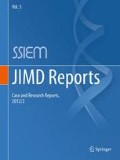Abstract
Hyperargininemia is a rare autosomal recessive disorder of the last step of the urea cycle characterized by a deficiency in liver arginase1. Clinically, it differs from other urea cycle defects by a progressive paraparesis of the lower limbs (spasticity and contractures) with hyperreflexia, neurodevelopmental delay and regression in early childhood. Growth is affected as well. Hyperammonemia is episodic, if present at all. The disease is caused by mutations in the ARG1 gene; there are approximately 20 different known ARG1 mutations with considerable genetic heterogeneity. We describe two Arab siblings with a late diagnosis of hyperargininemia and present the genetic findings in their family. As ARG1 sequencing was unrevealing despite suggestive clinical and laboratory findings, molecular cDNA analysis was performed. The ARG1 expression pattern identified a 125-bp out-of-frame insertion between exons 3 and 4, leading to the addition of 41 amino acids and a premature termination codon TGA at the sixth codon downstream. The insertion originated at intron 3 and was attributable to a novel c.305 + 1323 t > c intronic base change that enabled an enhancement phenomenon. This is the first reported exon-splicing-enhancer mutation in patients with hyperargininemia. The clinical course and genetic findings emphasize the possibility that hyperargininemia causes neurological deterioration in children and the importance of analyzing the expression pattern of the candidate gene when sequencing at the DNA level is unrevealing.
Competing interests: None declared.
Access this chapter
Tax calculation will be finalised at checkout
Purchases are for personal use only
References
Braga AC, Vilarinho L, Ferreira E, Rocha H (1997) Hyperargininemia presenting as persistent neonatal jaundice and hepatic cirrhosis. J Pediatr Gastroenterol Nutr 24:218–221
Brusilow SW, Horwich AL (2001) Urea cycle enzymes. In: Sriver CR, Baudet AL, Sly WS, Valle D (eds) The metabolic bases of inherited diseases, 8th edn. McGraw-Hill, New York, pp 1909–1963
Cardoso ML, Martins E, Vasconcelos R, Vilarinho L, Rocha J (1999) Identification of a novel R21X mutation in the liver-type arginase gene (ARG1) in four Portuguese patients with argininemia. Hum Mutat 14:355–356
Crombez EA, Cederbaum SD (2005) Hyperargininemia due to liver arginase deficiency. Mol Genet Metab 84:243–251
De Deyn PP, Marescau B, Qureshi IA (1997) Hyperargininemia: A treatable inborn error of metabolism? In: De Deyn PP, Marescau B, Qureshi IA et al (eds) Guanidino compounds in biology and medicine, vol 2. John Libbey & Company Ltd, London, pp 53–69
Gomes Martins E, Santos Silva E, Vilarinho S, Saudubray JM, Vilarinho L (2011) Neonatal cholestasis: an uncommon presentation of hyperargininemia. J Inhert Metab Dis. [Epub ahead of print] doi: 10.1007/s10545-10-9263-7, Jan 13 Online
Korman SH, Gutman A, Stemmer E, Kay BS, Ben-Neriah Z, Zeigler M (2004) Prenatal diagnosis for arginase deficiency by second-trimester fetal erythrocyte arginase assay and first-trimester ARG1 mutation analysis. Prenat Diagn 24:857–860
Lee BH, Jin HH, Kim GH, Choi JH, Yoo HW (2011) Argininemia presenting with progressive spastic diplegia. Pediatr Neurol 44:218–220
Munder M, Mollinedo F, Calafat J et al (2005) Arginase 1 is constitutively expressed in human granulocytes and participates in fungicidal activity. Blood 105:2549–2556
Picker JD, Puga AC, Levy HL et al (2003) Arginase deficiency with lethal neonatal expression: evidence for the glutamine hypothesis of cerebral edema. J Pediatr 142:349–352
Prasad AN, Breen JC, Ampola MG, Rosman NP (1997) Argininemia: A treatable genetic cause of progressive spastic diplegia simulating cerebral palsy: case reports and literature review. J Child Neurol 12:301–309
Scaglia F, Lee B (2006) Clinical, biochemical and molecular spectrum of hyperargininemia due to arginase 1 deficiency. Am J Med Genet C Semin Med Genet 142C:113–120
Sparkes RS, Dizikes GJ, Klisak I et al (1986) The gene for human arginase (ARG1) is assigned to chromosome band 6q23. Am J Hum Genet 39:186–193
Vockley JG, Goodman BK, Tabor DE et al (1996) Loss of function mutations in conserved region of the human arginase 1 gene. Biochem Mol Med 59:44–51
Author information
Authors and Affiliations
Corresponding author
Editor information
Editors and Affiliations
Additional information
Communicated by: verena peters
Appendices
Take Home Message
A late diagnosis of hyperargininemia should be considered in pediatric patients with neurodevelopmental delay and regression in early childhood.
When cDNA sequencing is unrevealing, the expression pattern of the candidate gene should be analyzed for identification of potential novel mutations.
Details of Contributors
-
1.
Dr. Haimi-Cohen collected and analyzed the clinical data, described the patients, and drafted and edited the manuscript.
-
2.
Mrs. Bargal conducted and interpreted the molecular analysis and described the genetic findings in the manuscript.
-
3.
Dr. Zeigler supervised the molecular analysis investigation and contributed significantly in interpreting the data and revising the manuscript.
-
4.
Dr. Eidlitz-Markus helped in the collection and analysis of the clinical data and made a great contribution to the writing of the manuscript.
-
5.
Mrs. Zuri contributed to all stages of the molecular analysis and the interpretation of its results and assisted in revising the manuscript.
-
6.
Dr. Zeharia initiated the study. He contributed substantially to coordination of the clinical and molecular data of the study, to its design, and to the revision of the manuscript.
Guarantor of Study
Yishai Haimi-Cohen
Patient Consent
Not applicable
Competing Interests
None of the authors has a conflict of interest.
Funding
No funding was received for this study.
Rights and permissions
Copyright information
© 2011 SSIEM and Springer-Verlag Berlin Heidelberg
About this chapter
Cite this chapter
Cohen, Y.H., Bargal, R., Zeigler, M., Markus-Eidlitz, T., Zuri, V., Zeharia, A. (2011). Hyperargininemia: A Family with a Novel Mutation in an Unexpected Site. In: JIMD Reports - Case and Research Reports, 2012/2. JIMD Reports, vol 5. Springer, Berlin, Heidelberg. https://doi.org/10.1007/8904_2011_101
Download citation
DOI: https://doi.org/10.1007/8904_2011_101
Received:
Revised:
Accepted:
Published:
Publisher Name: Springer, Berlin, Heidelberg
Print ISBN: 978-3-642-28095-5
Online ISBN: 978-3-642-28096-2
eBook Packages: Biomedical and Life SciencesBiomedical and Life Sciences (R0)

